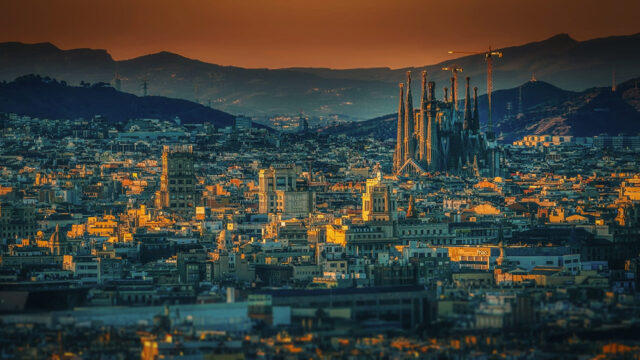Introduction
Barcelona, the vibrant capital of Catalonia in Spain, is a city known for its rich history, awe-inspiring architecture, and lively cultural scene. From amazing landmarks to stunning beaches, Barcelona offers a variety of attractions that draws millions of visitors each year. In this article, you will delve into some of the most popular touristic attractions that make Barcelona a popular destination travelers from around the world.
Sagrada Familia
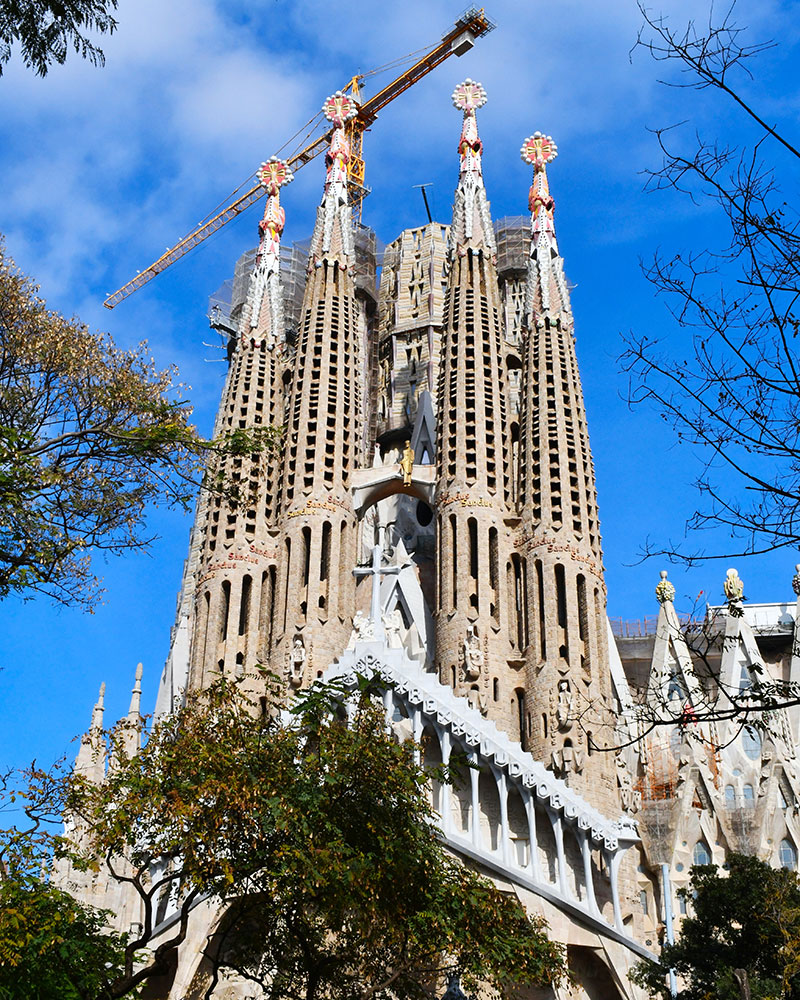
Antoni Gaudí’s masterpiece, the Sagrada Familia, stands tall as an iconic symbol of Barcelona. This breathtaking basilica, still under construction, showcases Gaudí’s distinctive architectural style with its intricate facades and towering spires.
A visit to the Sagrada Familia allows you to marvel at its stunning stained glass windows, intricately carved stone details, and inspiring interior. The mixture of modernist and Gothic elements creates a spiritual and surreal experience for visitors.
Construction began in 1882 and is still ongoing, making it a living testament to Gaudí’s vision. The basilica is a fusion of various architectural styles, including Gothic, Art Nouveau, and curvilinear modernism.
The basilica features three facades, each representing a different phase of Christ’s life: the Nativity Façade, the Passion Façade, and the Glory Façade. The Nativity Façade, facing the sunrise, is a celebration of birth.
The Passion Façade, on the western side, portrays the suffering and crucifixion of Christ with stark, angular sculptures. The Glory Façade, still under construction, will represent the eternal glory of Christ.
Step inside the Sagrada Familia, and you will be greeted by the magnificent interior, The columns inside the basilica resemble a forest, with branching forms that evoke the feeling of being in a sacred woodland.
Gaudí infused profound religious symbolism throughout the Sagrada Familia. Every detail, from the sculpted elements to the choice of materials, holds meaning. The design elements draw inspiration from nature and reflect Gaudí’s belief in the harmonious relationship between God, humanity, and the natural world.
Sagrada Familia Museum offers visitors a deeper understanding of Gaudí’s architectural genius and the history of the basilica. The museum displays models, drawings, and photographs, providing insight into the construction techniques and Gaudí’s visionary concepts.
Park Guell
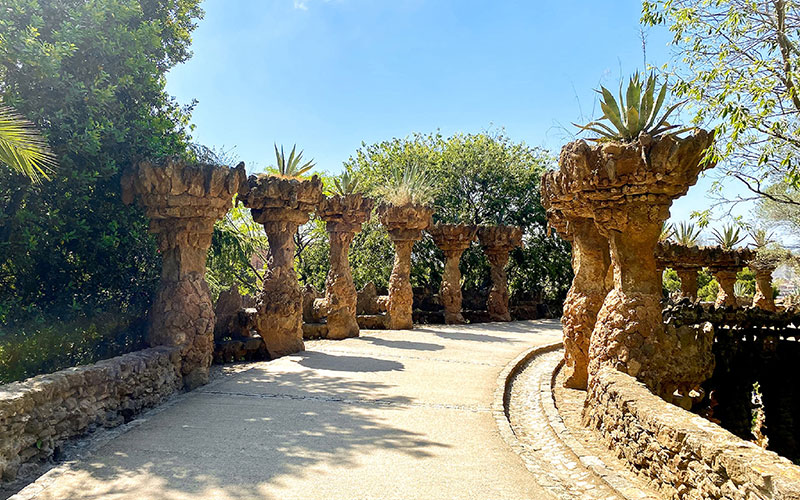
Designed by the renowned Catalan architect Antoni Gaudí, Park Güell is a testament to his distinctive artistic style and imaginative vision. It was built between 1900 and 1914 and was originally intended to be a residential garden city project commissioned by Eusebi Güell, a wealthy Catalan industrialist and Gaudí’s patron.
Gaudí incorporated his signature organic shapes, vibrant colors, and intricate tile work throughout the park. The use of natural stone, mosaics made from broken ceramic tiles known as trencadís, and the integration of the surrounding natural landscape create a harmonious and magical atmosphere.
The park is divided into two main areas: the Monumental Zone and the Free Access Zone. The Monumental Zone requires an entrance ticket and is the most famous and visually striking part of the park.
It features several notable structures, including the iconic dragon-like salamander statue (known as “El Drac”) at the entrance stairway, the Hypostyle Room with its impressive columns, and the colorful ceramic-tiled bench surrounding the central square.
Recognizing its architectural and artistic significance, Park Güell was declared a UNESCO World Heritage Site in 1984. It stands as a testament to Gaudí’s genius and his contribution to the Art Nouveau movement.
Park Güell attracts millions of visitors eah year, making it one of Barcelona’s most popular tourist attractions. To preserve the park’s unique atmosphere and protect its delicate structures, the number of visitors allowed in the Monumental Zone is regulated, and it is recommended to reserve tickets in advance.
Gothic Quarter
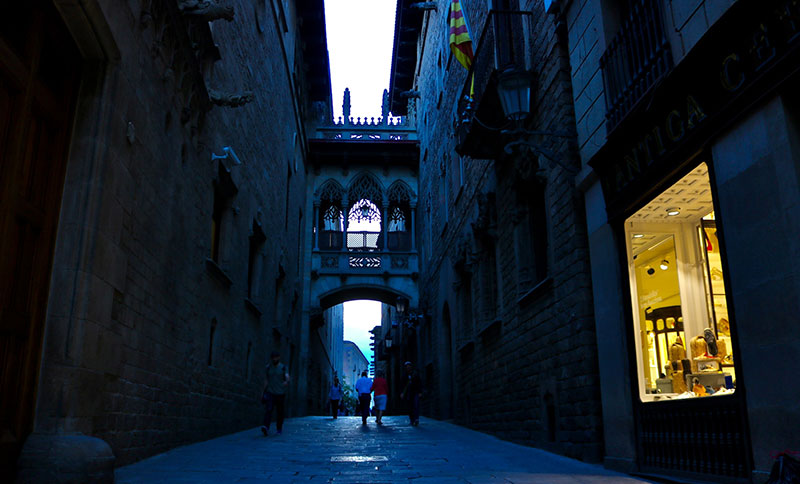
Stepping into the Gothic Quarter is like traveling back in time to medieval Barcelona. This labyrinthine neighborhood is filled with narrow cobblestone streets, charming squares, and historic buildings. Discover architectural gems such as the Barcelona Cathedral and the Plaça Reial, and lose yourself in the captivating ambiance of this atmospheric district. The Gothic Quarter is a treasure trove for history lovers and photography enthusiasts.
The Gothic Quarter is one of the oldest parts of Barcelona, dating back over 2,000 years. Its narrow, labyrinthine streets are a testament to the city’s Roman origins. The neighborhood was built on the ancient Roman settlement of Barcino, and many remnants of the Roman walls and streets can still be seen today.
The Gothic Quarter is well-known for its stunning architecture, reflecting various periods of history. Gothic, Romanesque, and medieval buildings dominate the neighborhood, with their intricate facades, arched doorways, and charming balconies.
Highlights include the Barcelona Cathedral (Catedral de la Santa Creu I Santa Eulàlia), a magnificent example of Catalan Gothic architecture, and Plaça Reial, a picturesque square adorned with palm trees and lined with beautiful neoclassical buildings.
The Gothic Quarter is home to several museums and cultural landmarks. The Picasso Museum (Museu Picasso) houses an extensive collection of works by the renowned artist, showcasing his early years and formative works.
The History Museum of Barcelona (MUHBA) offers insight into the city’s history through archaeological remains and multimedia exhibits. Additionally, the Jewish Quarter (Call) provides a glimpse into the city’s Jewish heritage with its narrow streets and historic sites.
The Gothic Quarter exudes a bohemian atmosphere with its vibrant mix of trendy bars, jazz clubs, and art galleries. The neighborhood comes alive in the evenings, offering a bustling nightlife scene. From cozy wine bars to lively gatherings and joints, there are endless options to indulge in the local culinary delights and soak in the unique charm of the area.
Camp Nou
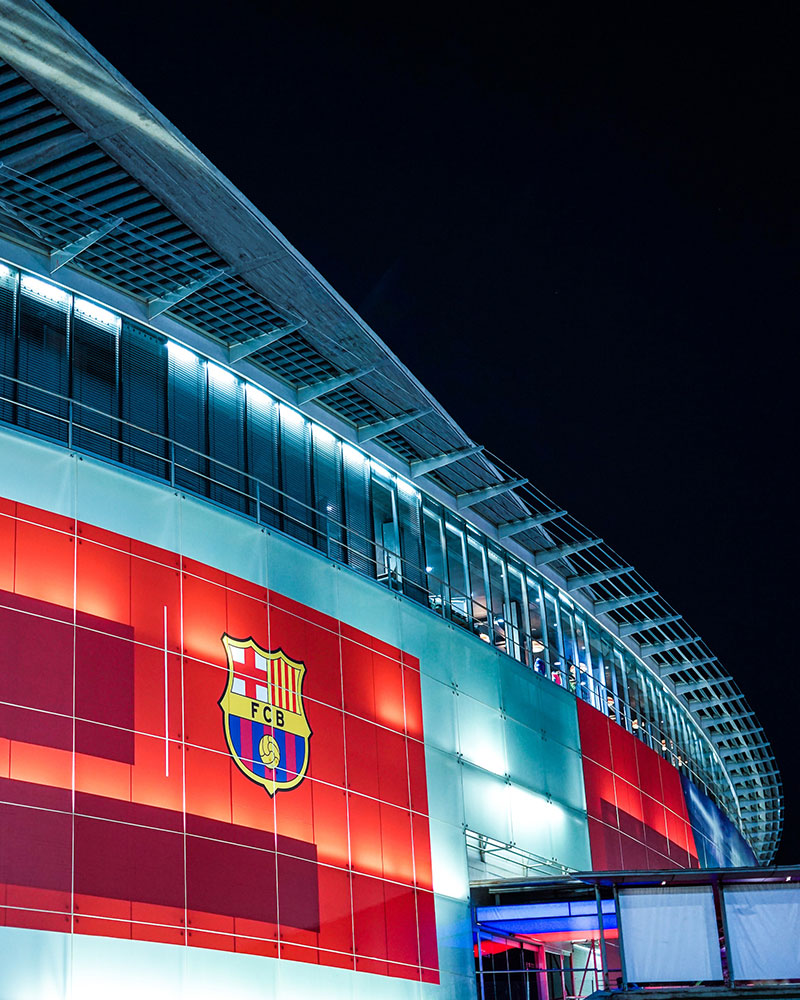
For football fanatics, a visit to Camp Nou, the iconic stadium of FC Barcelona, is an absolute must. Step into the legendary grounds where football history has been made, and explore the museum to learn about the club’s illustrious past. Experience the electric atmosphere of a match if you have the chance, or take a guided tour to discover the inner workings of one of the world’s most famous football clubs.
Camp Nou is the largest stadium in Europe and the third-largest football stadium in the world in terms of capacity. It can accommodate more than 99,000 spectators, creating an electrifying atmosphere during matches and events. The sheer size of the stadium makes it an inspiring sight for football enthusiasts and visitors alike. The design of Camp Nou is a blend of modernism and functionality.
The stadium’s distinctive feature is its sweeping, curved stands that enclose the pitch, providing excellent visibility from every seat. The roof structure is supported by slender columns, allowing for unobstructed views throughout the stadium.
Camp Nou offers a unique opportunity for fans and visitors to explore the history and legacy of FC Barcelona through the Camp Nou Experience. The experience includes a visit to the FC Barcelona Museum, where you can discover the club’s trophies,other achivements, and interactive exhibits that showcase the team’s achievements. Guided tours take you behind the scenes, allowing access to the player tunnel, the pitchside area, the press room, and the team’s locker room.
La Rambla
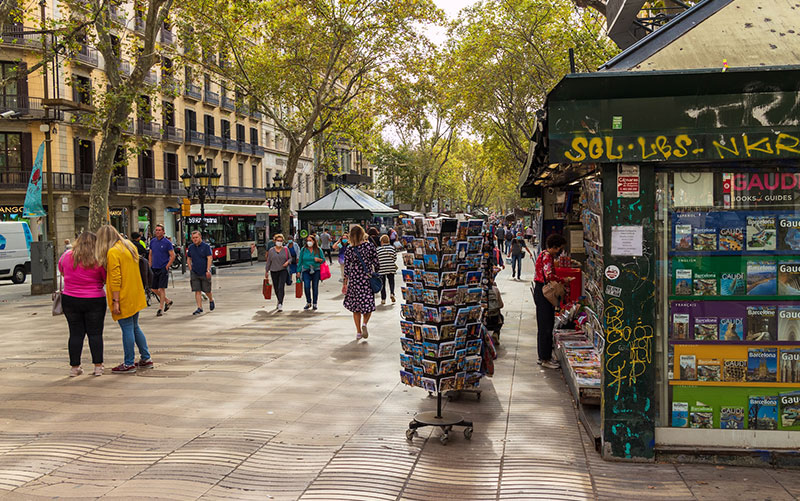
La Rambla, Barcelona’s most famous boulevard, is a bustling promenade that stretches from Plaça de Catalunya to the Mediterranean Sea. Lined with cafes, shops, and street performers, it offers a vibrant atmosphere that captures the city’s spirit. Explore the Mercat de Sant Josep de la Boqueria, a lively market where you can taste delicious local specialties. From flower stalls to human statues, La Rambla provides an authentic slice of Barcelona’s cultural heritage.
La Rambla is always buzzing with activity and is considered the heartbeat of Barcelona. It is a lively promenade that attracts both locals and tourists alike. From street performers, artists, and human statues to flower stands, newsstands, and outdoor cafes, the street is teeming with energy and a vibrant ambiance.
One of the distinctive features of La Rambla is its tree-lined pedestrian walkway. Strolling down the boulevard, you will find a canopy of tall plane trees providing shade during the warmer months. The tree-lined pathway creates a pleasant and refreshing environment.
La Rambla is dotted with notable landmarks and attractions, making it a popular destination for visitors. Some of the highlights include:
- Boqueria Market: Located just off La Rambla, Mercat de Sant Josep de la Boqueria (Boqueria Market) is a renowned food market where you can explore an array of fresh produce, seafood, meats, and local delicacies.
- Liceu Theatre: The Gran Teatre del Liceu, or simply Liceu, is Barcelona’s famous opera house. Its grand façade is an architectural marvel, and it hosts a variety of performances, including opera, ballet, and concerts.
- Canaletes Fountain: Located at the top end of La Rambla, the Font de Canaletes is a popular meeting point and a symbol of good luck for football fans. According to local legend, drinking water from the fountain ensures you’ll return to Barcelona.
Picasso Museum
The Picasso Museum is located in the El Raval neighborhood of Barcelona, in the historic Gothic Quarter (Barri Gòtic). The museum has an extensive collection of over 4,200 artworks by Picasso, showcasing the different stages and styles of his prolific career.
The collection includes paintings, sculptures, drawings, ceramics, engravings, and prints. The artworks on display span from Picasso’s early years to his Blue Period, Rose Period, and his pioneering contributions to Cubism.
One of the unique aspects of the Picasso Museum in Barcelona is its focus on Picasso’s formative years and his close connection to the city. The collection includes a significant number of his early works, created during his time in Barcelona between 1895 and 1904. These pieces offer insights into his artistic development and the influences that shaped his style.
In addition to the permanent collection, the museum hosts temporary exhibitions that explore various aspects of Picasso’s art or showcase the works of other artists. These exhibitions offer fresh perspectives and insights into Picasso’s legacy and his influence on contemporary art. The museum also organizes workshops, lectures, concerts, and other cultural events to engage visitors of all ages.
The Picasso Museum is not only a space for exhibiting artworks but also a center for research and education. It houses a specialized library and archive dedicated to Picasso’s life and work. The museum’s educational programs cater to students, scholars, and art enthusiasts, offering workshops, guided tours, and educational resources to deepen the understanding of Picasso’s artistic contributions.
Casa Mila
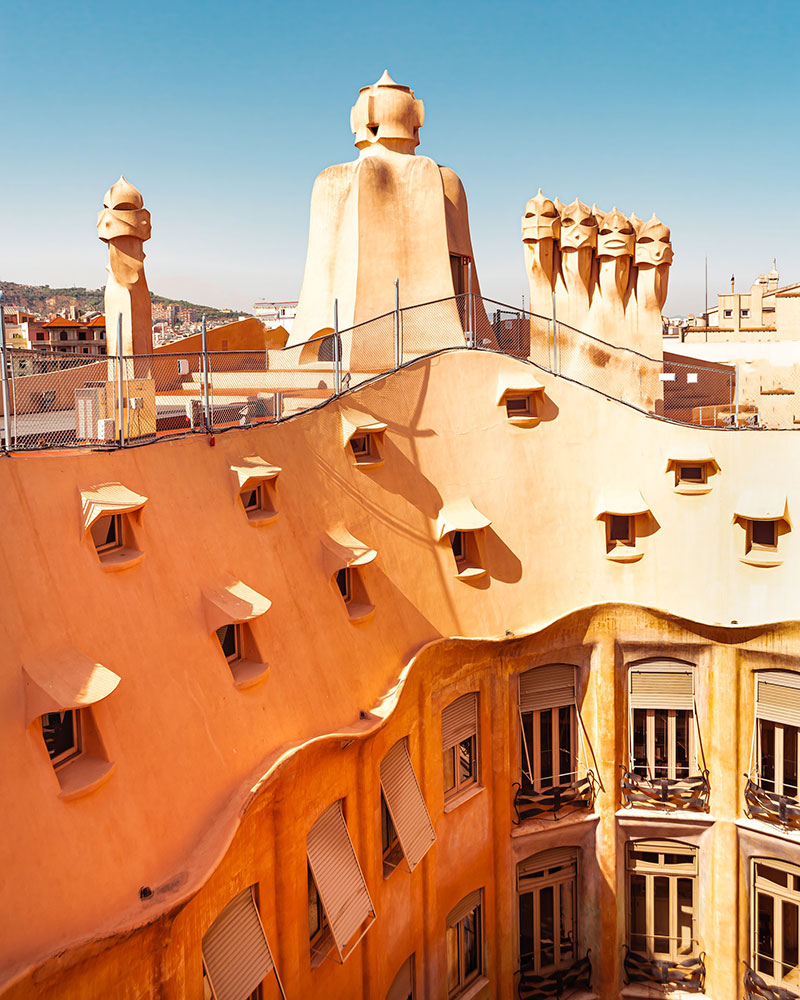
Casa Mila was constructed between 1906 and 1912 for the Milà family and was intended to serve as both a residence and an apartment building. Gaudí incorporated several structural innovations in Casa Mila.
The building lacks load-bearing walls, allowing for more flexible interior layouts. Instead, the floors are supported by a system of columns and arches, offering greater freedom in the arrangement of spaces. Casa Mila consists of several floors, with the ground floor originally housing the Milà family’s residence. The upper floors were designed as apartments for rent. The interior spaces feature Gaudí’s unique design elements, including curved walls, fluid transitions between rooms, and natural light.
Located on the fourth floor, the Espai Gaudí is a museum dedicated to the life and work of Antoni Gaudí. It provides insight into the architect’s creative process through a collection of drawings, models, and other exhibits.
Visitors can explore the building’s interior, including a recreated apartment that showcases the architectural style and interior design of the early 20th century. The rooftop offers stunning views of Barcelona’s cityscape.
Casa Batllo
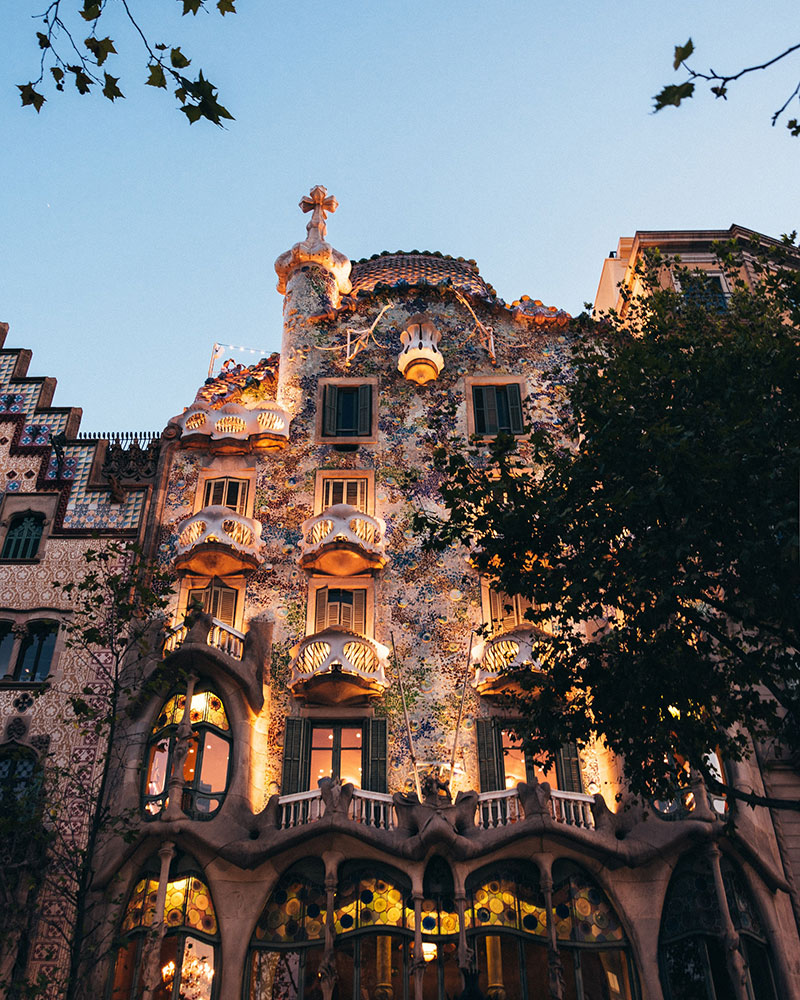
Also designed by Antoni Gaudí, Casa Batlló is a residential building renowned for its imaginative and inspiring design. Built between 1904 and 1906 for the Batlló family. Gaudí was commissioned to renovate the existing building, and he transformed it into a unique and visually striking structure. The façade is characterized by a vibrant mosaic of colorful ceramic tiles, undulating shapes, and skeletal balconies resembling the bones of a dragon or dinosaur.
The façade of Casa Batlló is one of its most distinctive features. It is covered in colorful fragments of broken ceramic tiles, known as trencadís, which create a mosaic-like effect. The tiles range in color from blue and green to golden and reddish hues, and they contribute to the building’s remarkable design.
Gaudí paid careful attention to every aspect of Casa Batlló’s interior design. The windows are designed to allow optimal natural light to enter the rooms, and they are adorned with stained glass in lively colors and organic patterns. The central source of light, known as the “Pati de llums,” brings light deep into the building’s core.
Montjuic
For breathtaking panoramic views of Barcelona, head to Montjuïc. This hill overlooking the city is home to several attractions, including the Montjuïc Castle, the Magic Fountain, and the Olympic Stadium. Take a cable car ride to the top of Montjuïc and enjoy the stunning vistas of the city and the Mediterranean Sea. The hill also boasts beautifully landscaped gardens, making it an ideal spot for a leisurely picnic or a peaceful stroll.
Conclusion
Whether you find yourself impressed by the medieval charm of the Gothic Quarter or find yourself wandering along the bustling promenade of La Rambla, Barcelona’s energy and allure are sure to leave an indelible mark on your heart.
With its Mediterranean beaches, delectable cuisine, and warm hospitality, Barcelona tempts travelers to embark on a journey of exploration and discovery. So, pack your bags, embrace the spirit of adventure, and allow Barcelona to captivate you with its amazing blend of history, culture, and modernity. An unforgettable experience awaits you in this vibrant Spanish gem. There are also other dazzling places and destinations to discover all across Europe, if you have enough time and willingness explore them too, Read More

